| Article ID | Journal | Published Year | Pages | File Type |
|---|---|---|---|---|
| 152372 | Chemical Engineering Journal | 2009 | 7 Pages |
The aim of gravity thickening processes is to increase the solids concentration of particulate slurries. Gravity thickening depends on the difference in densities between the solid and liquid phases. The solids settle to a more concentrated slurry zone towards the underflow at the thickener base, while relatively solids free liquid rises to the overflow at the top. Predictive modelling of gravity thickener performance from experimentally determined material properties has been shown to under predict throughput by a factor of up to 100. One phenomenon proposed to account for some of this discrepancy is aggregate densification, whereby aggregates compact and become smaller when subjected to shear forces in the thickening process. As the aggregates decrease in size, through densification, the tortuosities around the aggregates will decrease, thus leading to a significant net decrease in the resistance to fluid flow. Dewatering theory has been applied to predict the impact of aggregate densification on the material properties that describe dewatering. The anticipated decrease in aggregate size and associated increase in the density of these aggregates is expected to increase the settling rate. It is further expected on this basis that the material will settle to higher solids concentrations. The impact of these changes on gravity thickening performance is modelled and predicted to be significant.
